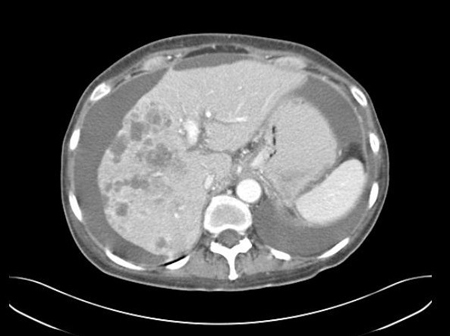Resumo
Definition
History and exam
Key diagnostic factors
- dor (por exemplo, abdome, tórax, osso)
- história familiar de câncer
- sintomas constitucionais
Other diagnostic factors
- icterícia
- sintomas de pneumonia pós-obstrutiva
- hemoptise
- ascite
- adenopatia da cadeia cervical
- história pessoal de câncer prévio
- história de tabagismo
- massa palpável
- dor ou fraqueza neuropática
- cefaleias
- convulsões
- delirium
- história de consumo excessivo de bebidas alcoólicas
- hepatomegalia
Risk factors
- idade >60 anos
Diagnostic tests
1st tests to order
- hemograma completo
- perfil metabólico completo
- TC do tórax/abdome/pelve
- RNM
- biópsia (avaliação patológica)
- exames de coloração imuno-histoquímica
Tests to consider
- exame de sangue oculto nas fezes
- lactato desidrogenase
- urinálise
- tomografia por emissão de pósitrons com 18F-fluordesoxiglucose/TC (FDG-PET-TC)
- imagem da mama (mamografia, RNM, ultrassonografia)
- ultrassonografia transvaginal
- paracentese
- endoscopia
- laringoscopia direta, com ou sem esofagoscopia e broncoscopia
- marcadores tumorais séricos
- testes de biomarcadores genéticos
Emerging tests
- teste de tecido de origem
Treatment algorithm
identificação do sítio primário pendente
subtipo desfavorável: metástases múltiplas e/ou sem provável sítio primário
subtipo favorável: mulheres com linfadenopatia axilar isolada (provavelmente primária da mama)
subtipo favorável: mulheres com carcinomatose peritoneal de um adenocarcinoma papilar seroso (provavelmente de sítio primário ovariano)
subtipo favorável: carcinoma pouco diferenciado com características neuroendócrinas (provavelmente câncer pulmonar de células pequenas primário)
subtipo favorável: tumores neuroendócrinos bem diferenciados (provavelmente sítio primário neuroendócrino)
subtipo favorável: adenocarcinoma com imuno-histoquímica colorretal (provavelmente sítio primário colorretal)
subtipo favorável: carcinoma pouco diferenciado do mediastino ou retroperitônio em homens <40 anos (provavelmente sítio primário testicular)
subtipo favorável: metástases ósseas blásticas com imuno-histoquímica/antígeno prostático específico sérico (provavelmente próstata como sítio primário)
subtipo favorável: lesão metastática única
subtipo favorável: doença oligometastática
Contributors
Authors
Michael S. Lee, MD
Associate Professor
Department of Gastrointestinal Medical Oncology
Division of Cancer Medicine
University of Texas MD Anderson Cancer Center
Houston
TX
Disclosures
MSL has consulted for Pfizer, Bayer, Delcath, and Imvax. His institution has received research funding from Amgen, Exelixis, Bristol-Myers Squibb, Pfizer, Rafael Pharmaceuticals, EMD Serono, Genentech/Roche, Merck, Arcus, and Shanghai EpiMab Biotherapeutics. MSL is the author of a number of papers cited in this topic.
Acknowledgements
Dr Michael S. Lee would like to gratefully acknowledge Dr Ross C. Donehower, Dr David Cosgrove, and Dr Hatim Hussain, previous contributors to this topic.
Disclosures
RCD, DC, and HH declare that they have no competing interests.
Peer reviewers
Nikhil Khushalani, MD
Assistant Professor
Department of Medicine
Roswell Park Cancer Institute
Buffalo
NY
Disclosures
NK declares that he has no competing interests.
Zelig Tochner, MD
Associate Professor
Radiation Oncology
Children's Hospital of Philadelphia
Philadelphia
PA
Disclosures
ZT declares that he has no competing interests.
Justin Stebbing, MA, MRCP, MRCPath, PhD
Consultant Medical Oncologist/Senior Lecturer
Department of Medical Oncology
Imperial College/Imperial Healthcare NHS Trust
Charing Cross Hospital
London
UK
Disclosures
JS declares that he has no competing interests.
Peer reviewer acknowledgements
BMJ Best Practice topics are updated on a rolling basis in line with developments in evidence and guidance. The peer reviewers listed here have reviewed the content at least once during the history of the topic.
Disclosures
Peer reviewer affiliations and disclosures pertain to the time of the review.
References
Key articles
National Comprehensive Cancer Network. NCCN clinical practice guidelines in oncology: occult primary [internet publication].Full text
Krämer A, Bochtler T, Pauli C, et al. Cancer of unknown primary: ESMO clinical practice guideline for diagnosis, treatment and follow-up. Ann Oncol. 2023 Mar;34(3):228-46.Full text Abstract
National Institute for Health and Care Excellence. Metastatic malignant disease of unknown primary origin in adults: diagnosis and management. Apr 2023 [internet publication].Full text
Reference articles
A full list of sources referenced in this topic is available to users with access to all of BMJ Best Practice.

Differentials
- Carcinoma de células escamosas ou neuroendócrinos de sítio primário desconhecido
More DifferentialsGuidelines
- NCCN clinical practice guidelines in oncology: head and neck cancers
- NCCN clinical practice guidelines in oncology: occult primary
More GuidelinesLog in or subscribe to access all of BMJ Best Practice
Use of this content is subject to our disclaimer